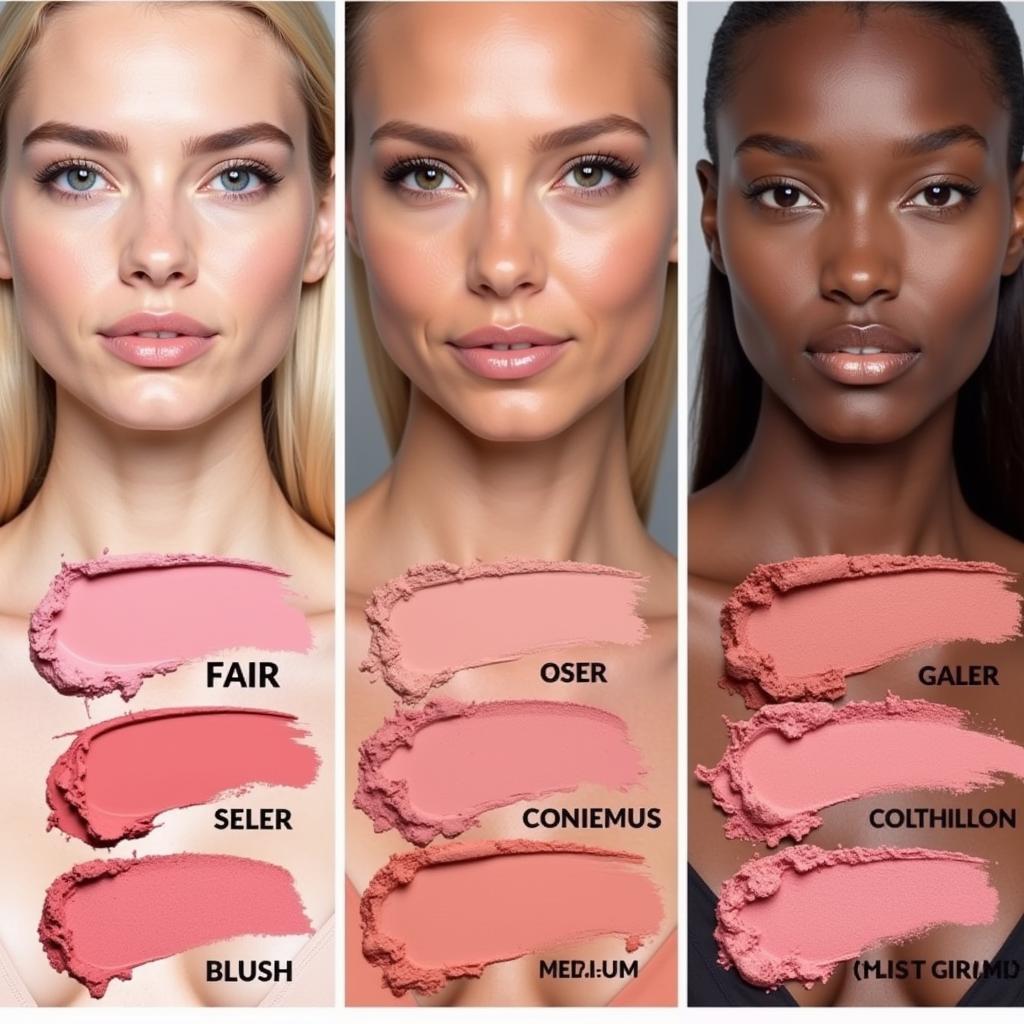Finding the perfect blush can feel like searching for a needle in a haystack. With so many shades, finishes, and formulas available, how do you choose the right blush color to complement your skin tone and enhance your natural beauty? This guide will break down everything you need to know to choose a blush that makes you look radiant.
Knowing your undertones is the first step in selecting a blush color that truly flatters. Do you have cool, warm, or neutral undertones? If you’re unsure, checking the veins on your inner wrist can offer a clue. Blue or purple veins typically indicate cool undertones, while green veins suggest warm undertones. If your veins appear blue-green, you likely have neutral undertones, giving you more flexibility with blush shades. Learning about what colors look good with warm undertones can help expand your makeup options.
Understanding Your Undertone and Skin Tone
Once you’ve identified your undertones, consider your overall skin tone. Are you fair, light, medium, tan, or deep? This will further refine your blush choices. For example, fair skin tones often look best with lighter shades of pink, peach, or coral, while deeper skin tones can carry off richer berry, plum, or terracotta hues. Remember, choosing the right blush color isn’t about masking your natural complexion, but rather enhancing it. For those planning a wedding, check out what colors do you wear to a wedding for some fashion inspiration.
Choosing Blush for Fair Skin
Fair skin tones benefit from soft, delicate blush colors. Think light pinks, peaches, and corals. These shades add a natural flush without overpowering your complexion. Avoid overly bright or dark shades, as they can look harsh against fair skin.
Choosing Blush for Medium Skin
Medium skin tones have a wider range of blush options. Rose, mauve, apricot, and berry shades all work beautifully. You can also experiment with slightly shimmery finishes to add a touch of radiance.
Choosing Blush for Deep Skin
Deep skin tones can embrace rich, vibrant blush colors. Deep berry, plum, terracotta, and even bright fuchsia can create a stunning look. Don’t be afraid to experiment with bold colors! You can also find inspiration from articles like con que colores combina el rosado to explore how pink complements various other colors.
 Choosing the Right Blush Color for Different Skin Tones
Choosing the Right Blush Color for Different Skin Tones
Considering Blush Formula and Finish
Besides color, the formula and finish of your blush play a crucial role in the final look. Powder blushes are versatile and easy to apply, while cream blushes offer a dewy, natural finish. Liquid and gel blushes provide a long-lasting, vibrant color payoff. Consider your skin type and desired look when choosing a formula. For those unsure about jewelry pairings, understanding what color jewelry goes with navy blue dress can be helpful.
Powder Blush
Powder blush is a classic choice, perfect for most skin types, especially oily or combination skin. It’s easy to blend and buildable, allowing you to control the intensity of the color.
Cream Blush
Cream blush creates a natural, dewy finish, ideal for dry or mature skin. It blends seamlessly into the skin for a healthy, radiant glow.
Liquid and Gel Blush
Liquid and gel blushes offer intense pigmentation and long-lasting wear. They can be applied with fingers or a brush for a seamless, natural look. If you’re considering outfit coordination for a wedding, it’s worth looking into whether the mother of bride and groom wear same color.
Matching Blush to Your Makeup Look
Your overall makeup look should also influence your blush choice. A natural, everyday look calls for a subtle, neutral blush, while a dramatic evening look can handle a bolder, more vibrant shade. Consider the colors you’re using on your eyes and lips to create a cohesive and balanced look.
“Choosing the right blush is about enhancing your natural beauty, not masking it,” says renowned makeup artist, Amelia Reed. “The goal is to create a healthy, radiant glow that complements your overall look.” Another expert, Sarah Chen, adds, “Don’t be afraid to experiment with different shades and formulas to find what works best for you.”
Conclusion
Choosing the right blush color is an art, but with a little understanding of your undertones, skin tone, and desired look, you can find the perfect shade to enhance your natural beauty. Remember to consider the formula and finish, as well as your overall makeup look. With the right blush, you can create a radiant, healthy glow that complements your unique style.
FAQ
-
What is the best blush color for cool undertones? Pink and rosy hues tend to flatter cool undertones.
-
How do I apply blush correctly? Smile and apply blush to the apples of your cheeks, blending upwards towards your temples.
-
Can I wear blush if I have oily skin? Yes, opt for a powder blush to help control shine.
-
What is the difference between blush and bronzer? Blush adds color to the cheeks, while bronzer adds warmth and definition.
-
How do I choose a blush for mature skin? Cream blushes offer a hydrating, natural finish that’s ideal for mature skin.
-
What if I have sensitive skin? Look for blushes formulated without fragrance or harsh chemicals.
-
Can I mix and match blush colors? Absolutely! Experiment to find your perfect custom shade.
Need more help choosing the right blush color? Contact us at Phone Number: 0373298888, Email: [email protected] Or visit us at 86 Cau Giay, Hanoi. We have a 24/7 customer service team.


